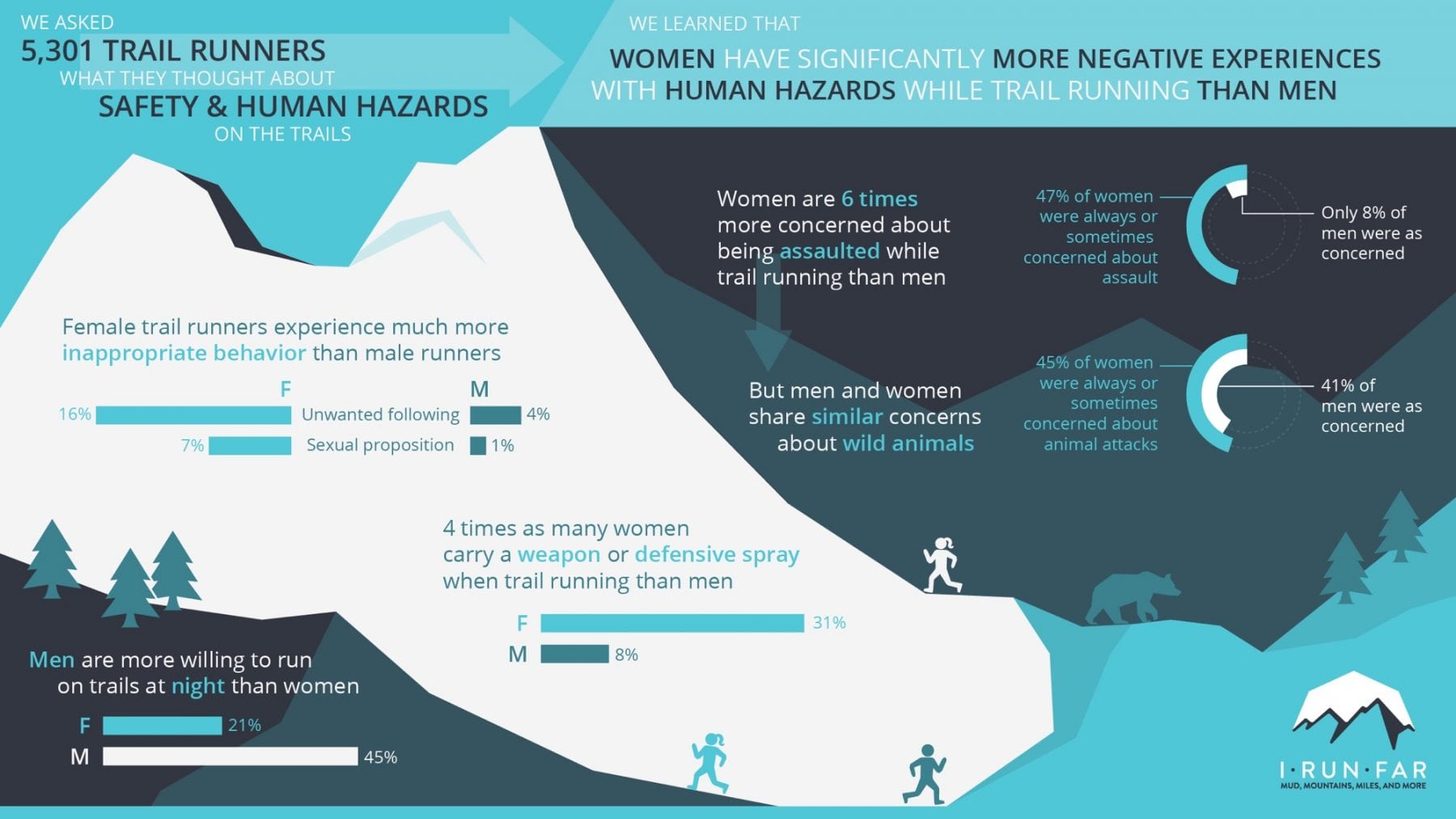Trail running has many common denominators for women and men, but safety concerns, safety behaviors, and experiences of harassment are not any of them. Before iRunFar’s Trail Running and Safety Survey, I’d never really thought about how my preparations for a trail run are different than my male buddies. I’d never thought about how my concerns and experiences are different either. But they are.
The results of iRunFar’s Trail Running and Safety Survey showed that female trail runners:
- Are more concerned about human hazards than males;
- Change their behavior to help maintain their safety from perceived human hazards more than males; and
- Experience verbal harassment and inappropriate behavior more than males.
To learn more, you can look back at the original survey and in-depth results of it in this long-form article.
If Ya’ Don’t Know, Now Ya’ Do!
I’m pretty sure my male trail running friends, like me, have never really thought about the profound impact these differences have. These guys are marvelously considerate to the runners in our group. They are consistently inclusive to both women and men, and, they care about the safety of female trail runners in our community. But just like I’ve never asked myself the question, How exactly would heading out for this run be different if I were a guy?, I don’t think they’ve spent time putting themselves in a female runners’ trail shoes. Because if we all had, we might have identified this as a problem that needs a solution, and we might have already done something about it. Now that we have the results of this survey and that we are asking ourselves these hard questions, I’m hoping we will now take action.
So, how can we make trail safety a common denominator for women and men?
Transforming the Trail Experience
I have a few suggestions for decreasing verbal harassment and inappropriate behavior on the trails. We can use them as a jumping-off point for our discussion.
Female trail runners are five times as likely to be sexually propositioned while trail running than males, suffer lewd hand gestures, and receive unsolicited cautionary comments. To change this, we could use what I’d like to call the “Kilian Heuristic:” If you wouldn’t say it to Kilian Jornet, don’t say it to a female trail runner.
Let’s test this out:
“Your butt looks great in that spandex, Kilian!”
“I’m running behind you because it’s a motivating view, Kilian.”
“Those shorts would look great on my bedroom floor, Kilian.”
“That trail’s pretty technical, Kilian. Be careful, honey.”
“You’re out here all alone, Kilian? Wow.”
And the “Kilian Corollary” would be: If you hear someone say something to a female trail runner that they wouldn’t say to Kilian Jornet, speak up! People struggle when they hear or see something that seems inappropriate. They think, I didn’t know what to say. What works well is a simple, “Hey, that’s not cool!” It’s short, to the point, and not particularly antagonistic.
These Kilian rules of thumb work for a lot of offensive behaviors too:
Would I make this hand gesture simulating sex at Kilian?
Would I wolf whistle at Kilian?
Unfortunately, they can’t address all offensive behaviors. Women are four times as likely to have someone follow them on a trail run than male runners. Few humans are fast enough to actually shadow Kilian, so we can’t use, “Would I follow Kilian uninvited?” Happily, you can fall back on the Golden Rule in this case: Do unto other [trail runner]s as you would have them do unto you.
“Would I want someone trailing me?”
And, remember, just because a female trail runner doesn’t tell you or your running group she found something offensive, doesn’t mean the environment wasn’t uncomfortable for her. The survey shows female trail runners are unquestionably bothered by unsolicited comments and attention. I can’t tell you the number of times I didn’t address comments about my appearance or another woman’s appearance because I didn’t want to make waves, or I didn’t want to take the time to do it. I just wanted run. There are a whole host of reasons that a woman might not tell you a sexist or paternalistic comment made her uncomfortable or annoyed. The trail running community is amazing, but it is not postsexual. So, again, rely on the Kilian Heuristic and Corollary. They, combined with that fallback Golden Rule, will rarely let you down.
Addressing Women’s Concerns and Behaviors
Our survey also showed women feel less safe on the trails than men do. A lot of men head out the door for a trail run without thinking about the number of people using the route, reports of harassment, the ability to flee or get help, and the availability of cell-phone reception. No so for women. Women think about these factors twice as much as men do. They cancel runs due to human-safety concerns, limit their running to daylight hours, and carry weapons or defensive spray more than men do. They also seek running partners almost four times as often as men.
How does our trail running community empower our female runners in this regard?
I think the answer lies with both intentionally addressing what we now know are issues and making ourselves vulnerable to misunderstanding and rejection.
We now know many women feel unsafe running alone, and we know women seek out running partners to mitigate this concern. So invite a female trail runner to run with you. Or set up a no-drop group run, or a night run, and seek out some female runners, especially novices, to participate. Could your intentions be misinterpreted? Yup. Could the invitation possibly annoy someone who felt safe already? Sure. Would that be uncomfortable and upsetting? Yup. Risk it anyway. That’s what I (and Brené Brown) mean by making yourself vulnerable. Because the flip side of being misunderstood or rejected is actually helping to remove this barrier for the women who are affected by it.
It’s Time for a Community Discussion
My suggestions and this article are meant to start our discussion about how to transform this unbalanced aspect of our community. Maybe you disagree with them. Why? What would you suggest instead? Or in addition? We know that this problem manifests itself differently in different communities and geographies. What are the specific issues in your community? And how can they be addressed locally? A nearly miraculous 5,301 people participated in the Trail Running and Safety Survey and helped us identify the problem. We need to hear from you again to figure out solutions.

